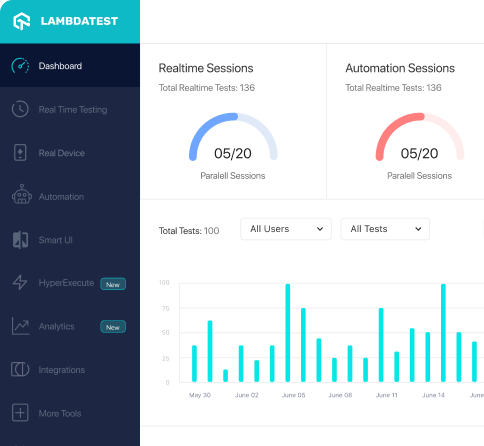How to use TestFrameworkExecutionTest class of com.tngtech.jgiven.testframework package
Best JGiven code snippet using com.tngtech.jgiven.testframework.TestFrameworkExecutionTest
Source: TestFrameworkExecutionTest.java
...16@FeatureJUnit517@FeatureJUnit18@FeatureTestNg19@RunWith(Parameterized.class)20public class TestFrameworkExecutionTest21 extends JGivenScenarioTest<GivenScenarioTest<?>, WhenTestFramework<?>, ThenTestFramework<?>> {22 public final TestFramework testFramework;23 @Parameters24 public static Iterable<Object[]> testFrameworks() {25 return Arrays.stream(TestFramework.values())26 .map(value -> new Object[] {value})27 .collect(Collectors.toList());28 }29 public TestFrameworkExecutionTest(TestFramework testFramework) {30 this.testFramework = testFramework;31 }32 @Test33 @FeaturePending34 public void failing_tests_annotated_with_Pending_are_ignored() {35 given().a_failing_test()36 .and().the_test_is_annotated_with_Pending();37 when().the_test_is_executed_with(testFramework);38 then().the_test_is_ignored();39 }40 @Test41 @FeaturePending42 public void passing_tests_annotated_with_Pending_are_ignored() {43 given().a_passing_test()...TestFrameworkExecutionTest
Using AI Code Generation
1[com.tngtech.jgiven.testframework.TestFrameworkExecutionTest]: # (Language: java)2[com.tngtech.jgiven.testframework.TestFrameworkExecutionTest]: # (Language: groovy)3[com.tngtech.jgiven.testframework.TestFrameworkExecutionTest]: # (Language: scala)4[com.tngtech.jgiven.testframework.TestFrameworkExecutionTest]: # (Language: kotlin)5[com.tngtech.jgiven.testframework.TestFrameworkExecutionTest]: # (Language: scala2)6[com.tngtech.jgiven.testframework.TestFrameworkExecutionTest]: # (Language: scala3)TestFrameworkExecutionTest
Using AI Code Generation
1public class TestFrameworkExecutionTest extends JGivenTestFrameworkExecutionTest<TestFrameworkExecutionTest.TestStage> {2 public void testJGivenTestFrameworkExecution() throws Exception {3 given().a_test_case_that_executes_a_scenario();4 when().the_test_case_is_executed();5 then().the_test_case_should_fail();6 }7 public static class TestStage extends Stage<TestStage> {8 public TestStage a_test_case_that_executes_a_scenario() {9 return self();10 }11 public TestStage the_test_case_is_executed() {12 return self();13 }14 public TestStage the_test_case_should_fail() {15 return self();16 }17 }18}Blogs
Check out the latest blogs from LambdaTest on this topic:
One of the essential parts when performing automated UI testing, whether using Selenium or another framework, is identifying the correct web elements the tests will interact with. However, if the web elements are not located correctly, you might get NoSuchElementException in Selenium. This would cause a false negative result because we won’t get to the actual functionality check. Instead, our test will fail simply because it failed to interact with the correct element.
How do we acquire knowledge? This is one of the seemingly basic but critical questions you and your team members must ask and consider. We are experts; therefore, we understand why we study and what we should learn. However, many of us do not give enough thought to how we learn.
The fact is not alien to us anymore that cross browser testing is imperative to enhance your application’s user experience. Enhanced knowledge of popular and highly acclaimed testing frameworks goes a long way in developing a new app. It holds more significance if you are a full-stack developer or expert programmer.
I routinely come across test strategy documents when working with customers. They are lengthy—100 pages or more—and packed with monotonous text that is routinely reused from one project to another. Yawn once more— the test halt and resume circumstances, the defect management procedure, entrance and exit criteria, unnecessary generic risks, and in fact, one often-used model replicates the requirements of textbook testing, from stress to systems integration.
As part of one of my consulting efforts, I worked with a mid-sized company that was looking to move toward a more agile manner of developing software. As with any shift in work style, there is some bewilderment and, for some, considerable anxiety. People are being challenged to leave their comfort zones and embrace a continuously changing, dynamic working environment. And, dare I say it, testing may be the most ‘disturbed’ of the software roles in agile development.
Automation Testing Tutorials
Learn to execute automation testing from scratch with LambdaTest Learning Hub. Right from setting up the prerequisites to run your first automation test, to following best practices and diving deeper into advanced test scenarios. LambdaTest Learning Hubs compile a list of step-by-step guides to help you be proficient with different test automation frameworks i.e. Selenium, Cypress, TestNG etc.
LambdaTest Learning Hubs:
- JUnit Tutorial
- TestNG Tutorial
- Webdriver Tutorial
- WebDriverIO Tutorial
- Protractor Tutorial
- Selenium 4 Tutorial
- Jenkins Tutorial
- NUnit Tutorial
- Jest Tutorial
- Playwright Tutorial
- Cypress Tutorial
- PyTest Tutorial
YouTube
You could also refer to video tutorials over LambdaTest YouTube channel to get step by step demonstration from industry experts.
Most used methods in TestFrameworkExecutionTest
- testFrameworks
- TestFrameworkExecutionTest
- failing_tests_annotated_with_Pending_are_ignored
- passing_tests_annotated_with_Pending_are_ignored
- passing_tests_annotated_with_Pending_with_failIfPassed_set_to_true_fail
- failing_tests_annotated_with_Pending_with_failIfPassed_set_to_true_are_ignored
- failing_tests_annotated_with_Pending_with_executeSteps_set_to_true_are_ignored
- passing_steps_before_failing_steps_are_reported_as_passed
- the_error_message_of_a_failing_step_is_reported
- tag_annotations_appear_in_the_report_model
- description_annotations_on_test_classes_are_evaluated
Try LambdaTest Now !!
Get 100 minutes of automation test minutes FREE!!



